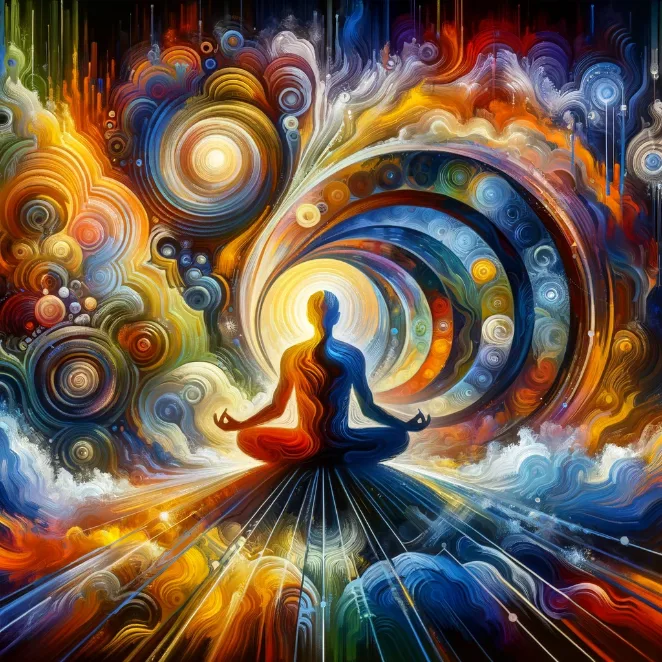
Mudra Meditation: Hand Gestures to Enhance Practice
In the diverse world of meditation practices, Mudra Meditation stands out as a unique method that combines mental focus with the power of physical gesture. Rooted in ancient traditions, this practice involves specific hand positions, known as 'mudras', each with its unique influence on energy flow and state of mind. These symbolic gestures serve as focal points in meditation, enhancing the practitioner's concentration and deepening their experience. In this article, we explore the intricate world of Mudra Meditation, uncovering the significance of these hand gestures and their transformative impact on meditation practice.
article by Hina Kurosawa
Introduction to Mudra Meditation
Mudra Meditation is an ancient technique that involves specific hand gestures, believed to influence the energy flow and mood of the practitioner. These gestures, or 'mudras', are an integral part of many spiritual practices, including yoga and meditation. Mudras are thought to create a subtle connection with the instinctual patterns in the brain, influencing emotions, behaviors, and physical well-being. By adopting certain hand positions, practitioners can deepen their meditation experience and achieve specific mental states more effectively. Each mudra has its unique significance and benefits, ranging from increased concentration to the promotion of inner peace. The practice of Mudra Meditation is simple yet powerful, offering an accessible tool for enhancing meditation and fostering a deeper connection to the self. The incorporation of these gestures adds a physical dimension to meditation, grounding the practice and enhancing focus.

Common Mudras and Their Meanings
One widely used mudra in meditation is the 'Gyan Mudra', where the thumb and index finger touch, forming a circle, while the other fingers remain extended. This gesture is said to enhance concentration and mental acuity, making it ideal for meditation focused on clarity and insight. The 'Anjali Mudra', often associated with gratitude and reverence, involves placing the palms together in front of the heart. This gesture symbolizes unification and is thought to foster a sense of balance and calmness. The 'Dhyana Mudra', with hands resting in the lap and fingers overlapping, is traditionally used for deep meditation and contemplation. It is believed to facilitate a flow of energy and promote a state of inner harmony. Exploring different mudras can provide varied experiences in meditation, each unlocking unique aspects of the practitioner's inner world.
Integrating Mudras into Meditation Practice
Incorporating mudras into meditation practice can enhance the experience significantly. To begin, choose a mudra that aligns with your meditation goals, whether it's calmness, concentration, or spiritual awakening. As you assume the mudra, bring your awareness to the sensation in your hands and the flow of energy. Maintain a comfortable posture, with the spine straight, allowing the energy to flow freely through the body. During the meditation, focus on the breath while maintaining the mudra, allowing it to anchor your attention and deepen your practice. It's important to approach Mudra Meditation with openness and attentiveness, observing how different gestures influence your mental and emotional state. Regular practice with mudras can lead to a deeper understanding of their impact and a more profound meditation experience.
Laura, a seasoned meditator, shares her experience with Mudra Meditation: "When I first incorporated mudras into my practice, I was skeptical about their impact. However, I soon noticed a significant shift in my focus and the depth of my meditation. Using the Gyan Mudra, I felt a heightened sense of clarity and calmness. It was as if the gesture helped to channel my energy and concentration. The physical connection of my fingers seemed to echo in my mind, creating a loop of focused awareness. Mudras have since become an essential part of my meditation routine, adding a layer of intention and purpose to my practice. They remind me that meditation is not just a mental exercise but a holistic practice involving body, mind, and spirit."
Benefits Beyond Meditation
The benefits of Mudra Meditation extend beyond the meditation session itself. Practicing mudras can improve mental clarity and reduce stress, positively impacting daily life. They can be used at any time to quickly center oneself and restore balance. For example, adopting the Anjali Mudra during stressful moments can bring a sense of calm and focus. Mudras also help in developing a deeper awareness of the body's energy flow, fostering a greater sense of connection with oneself. Regular practice can lead to improved emotional regulation and a more mindful approach to life's challenges. Mudra Meditation is a simple yet effective tool for maintaining mental and emotional well-being throughout the day.

Mudra Meditation offers a holistic approach to meditation, integrating physical gestures with mental focus. This practice not only enhances the depth and quality of meditation but also brings a greater sense of awareness and control over one's mental and emotional state. By incorporating mudras into meditation, practitioners can explore new dimensions of their practice and unlock deeper levels of tranquility and insight. Mudra Meditation is a testament to the power of combining physical and mental disciplines, offering a pathway to a more balanced and harmonious life.
Published: 11/24/2023
Modified: 11/24/2023
More predictions
Come back here soon to learn more about yourself and your future


Meditation and Carpentry: Crafting Presence
In the intricate world of craftsmanship, carpentry stands as a testament to the union of skill and creativity. However, for Jacob Stone, a seasoned carpenter with over two decades of experience, the introduction of meditation into his craft brought about an unexpected yet profound transformation. His story is not just about cutting and shaping wood but about how the integration of mindfulness reshaped his approach to carpentry and his life. It goes beyond the surface of tools and timber, exploring a deeper connection between the focused calm of meditation and the meticulous art of building. Jacob's journey reveals a fascinating interplay between the physicality of carpentry and the mental discipline of meditation, illustrating how mindfulness can transform a profession into an act of serene presence.


Serenity at 30,000 Feet: Meditation for Air Travel
Air travel, while an efficient means of transportation, often comes with its own set of stressors and anxieties. From the bustle of crowded airports to the confined spaces of airplanes, the journey can be taxing both physically and mentally. For frequent flyers and occasional travelers alike, finding a sense of calm amidst the chaos is crucial. This article explores the role of meditation in transforming air travel experiences, offering strategies to find peace and relaxation during flights. By integrating mindfulness and meditation techniques, travelers can turn their journey into an opportunity for relaxation and self-reflection.


Mindful Meditation: Resolving Conflicts with Awareness
In a world where disagreements and conflicts are inevitable, mindfulness emerges as a vital tool in navigating and resolving these challenges. Mindfulness, a state of being fully present and aware, can be transformative in conflict resolution. By incorporating mindfulness practices, such as meditation, individuals can approach conflicts with a clearer mind and a more balanced perspective. This article explores how mindfulness and meditation techniques can enhance conflict resolution skills, leading to more constructive and peaceful outcomes. Understanding this connection is essential for anyone seeking to resolve disputes effectively and maintain harmonious relationships.